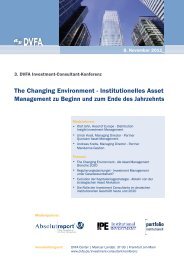KPIs for ESG - DVFA
KPIs for ESG - DVFA
KPIs for ESG - DVFA
Create successful ePaper yourself
Turn your PDF publications into a flip-book with our unique Google optimized e-Paper software.
Section A: Corporate strategy and <strong>ESG</strong> aspects<br />
Throughout this paper we will look at both focal points of <strong>ESG</strong>: identifying and managing risks and identifying and<br />
capitalising on business opportunities. Traditionally, the focal point of risk has been more prominent to investment<br />
professionals. As with many aspects of corporate conduct, there is the perceived wisdom that corporates do not gain<br />
a bonus <strong>for</strong> good corporate governance or reputation, but indeed suffer a massive discount when <strong>ESG</strong> issues are<br />
poorly managed. It will be one of the challenges of corporates to work out and communicate to investment<br />
professionals how good <strong>ESG</strong> per<strong>for</strong>mance translates into better corporate per<strong>for</strong>mance in capital market currencies,<br />
i.e. value of the company and stock price.<br />
A central feature of <strong>ESG</strong> is the identification and analysis of significant societal developments, along with the related<br />
opportunities and risks, with the aim of continually developing fields of <strong>ESG</strong> activity and associated measures. The<br />
future fields of activity provide impulses <strong>for</strong> the development of the corporate strategy and, at the same time, serve<br />
as a source of rein<strong>for</strong>cement <strong>for</strong> its implementation.<br />
Including <strong>ESG</strong> aspects in the development of the corporate strategy offers companies broad potential <strong>for</strong> future<br />
success. In addition to expanding the scope of risk management to include <strong>ESG</strong> issues, it opens up opportunities to<br />
increase cost efficiency and improve the long-term prospects <strong>for</strong> success of the company.<br />
The company should outline the importance of <strong>ESG</strong> <strong>for</strong> the corporate strategy and explain how <strong>ESG</strong> aspects are taken<br />
into account when implementing the strategy.<br />
Every company – to differing degrees – has a basic understanding of its ecological, social, and governance<br />
responsibilities. Factors that influence or determine this basic understanding include the quality and focus of<br />
supervision by management and supervisory boards, the quality of a company’s organisation and delegation of<br />
responsibilities by the management, the <strong>ESG</strong> philosophy as well as the integrity, ethical values and competence of the<br />
employees.<br />
As a rule, this basic understanding of <strong>ESG</strong> is also expressed through overarching frameworks, such as an <strong>ESG</strong> strategy,<br />
under which company-specific fields of <strong>ESG</strong> activity are defined, as well as in more practically oriented regulations<br />
such as a code of conduct, environmental management guidelines, donation rules, or group health and safety policies.<br />
Although these topics are already operational realities <strong>for</strong> many companies, there is often a lack of adequate<br />
documentation with respect to procedures and individual measures.<br />
The company should portray its understanding of <strong>ESG</strong>to the capital market – e.g. by developing and publishing an <strong>ESG</strong><br />
strategy – to enhance transparency about risk exposure. Company-wide, practically oriented guidelines should be<br />
made available online.<br />
Companies with <strong>ESG</strong> management are able to promptly identify future legislative initiatives or opinion shaping<br />
processes, which could lead to regulatory interventions. This allows them to anticipate such developments in their<br />
product development or corporate communications and position themselves as pioneers in the area of <strong>ESG</strong>. To<br />
achieve this, however, companies must have a process and assessment system in place to evaluate the relevance of<br />
<strong>ESG</strong> issues.<br />
The company should determine and communicate the current and future relevance of <strong>ESG</strong> topics <strong>for</strong> its own business<br />
activities – e.g. in <strong>ESG</strong> reports or via the Internet.<br />
Best practice example: Assessment system <strong>for</strong> relevance of <strong>ESG</strong> topics<br />
Formal requirements concerning <strong>ESG</strong> disclosure and reporting<br />
Current practice <strong>for</strong> <strong>ESG</strong> and CSR is to disclose <strong>ESG</strong>-relevant in<strong>for</strong>mation in a dedicated process and publish data in a<br />
separate report. The <strong>DVFA</strong> Committee on Non-financials, however, strongly recommends including CSR data as an<br />
integral part of statutory and legally required financial reporting. <strong>ESG</strong> data would gain visibility <strong>for</strong> investors as part of<br />
a management report, which was made a legal requirement <strong>for</strong> German companies through the accounting rule DRS<br />
15 (“Konzernlagebericht”). This would serve to reflect the importance of such data <strong>for</strong> analysis of the risk and<br />
opportunities of the company.<br />
© <strong>DVFA</strong> April 2010 ALL RIGHTS RESERVED. No part of this publication may be reproduced, stored in a retrieval system, or transmitted, in any <strong>for</strong>m or by any<br />
means, electronic, mechanical, recording, without the prior permission of the copyright holder.<br />
4

















